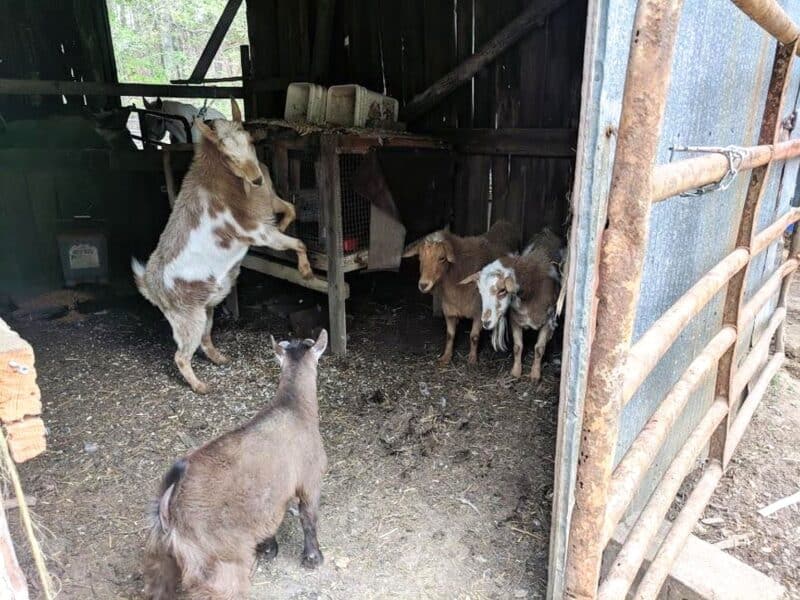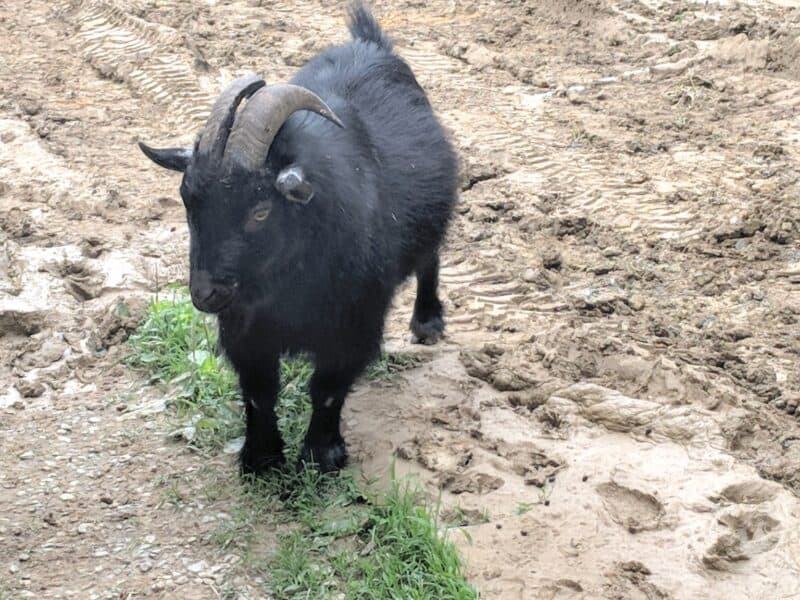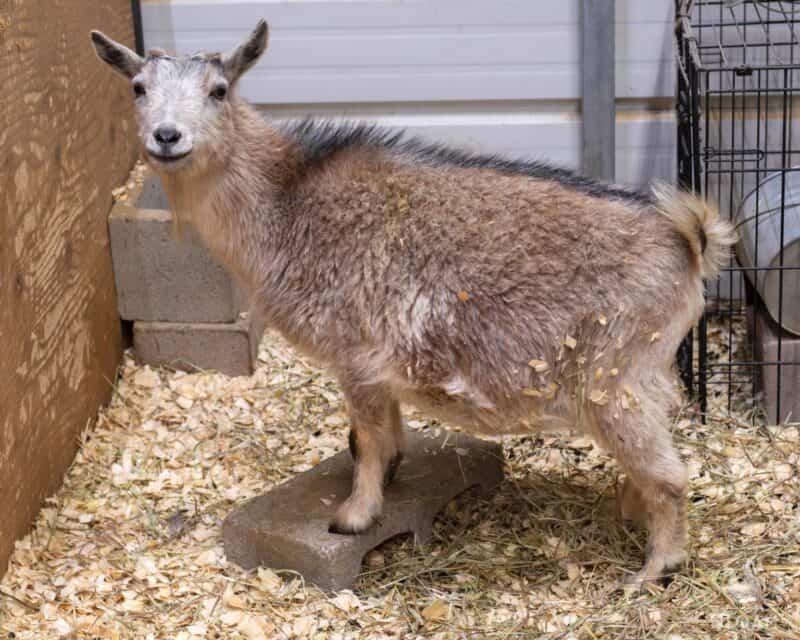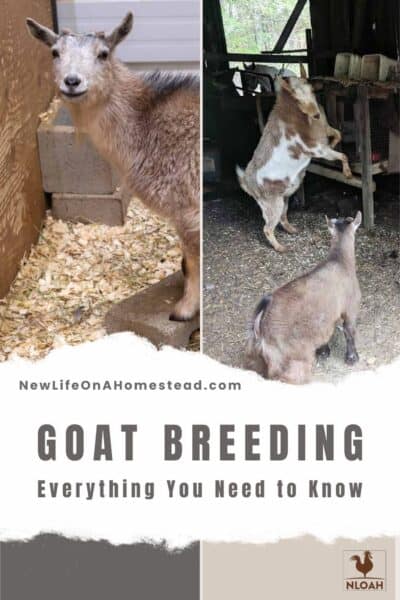If you want to do anything with your goats besides keep a couple around as pets, you’ve got to understand breeding. Sometimes confusing, rarely straightforward, and occasionally harrowing, breeding any livestock is a skillset unto itself, and goats particularly have a reputation as being unruly when it comes to making babies.

The bottom line is that this is mostly due to a lack of information about the finer points. The subtleties, if you will!
Breeding is often messy and stinky, and there’s nothing I can do about that, but if you want to grow the size of your herd the old-fashioned way, this is stuff you have to know. I’ll be telling you everything you need to know below, so let’s get a move on…
The Basics of Breeding
Before we even get started, I want you to keep something in mind when breeding your goats, or any other animal.
You can let nature take its course, meaning let them go at each other willy-nilly and just be happy with the results, but that won’t help the integrity and quality of your herd.
A better option is to carefully select animals for breeding that will promote, or intensify, desirable characteristics in successive generations while minimizing or eliminating wanted ones.
You should think twice before breeding any of your goats that are regularly sick, puny, have deformities or, in the case of purebreds, deviate from accepted breed standards.
This goes for both bucks, males, and does, females: bucks tend to get most of the attention because they will be breeding with many females and so their genetics are disproportionately focused on. Size, strength, health, coloring, etc.
All this stuff makes a difference, yes, but don’t neglect to consider the characteristics of the ladies, and particularly the characteristics that are essential for reproduction and successful kidding, traits like the size and shape of their udder and teats, milk volume, and so forth.
Selecting and successively breeding for lineage is an entire article, even a series of articles, but as long as you keep these basic ground rules in mind you can do a fine job of it without delving too far into the minutiae. So, with that said, let’s move on.
When are Goats Sexually Ready to Mate?
First things first: when are goats ready for mating? It varies between the sexes.
Bucks, unbelievably, might be capable of successful breeding, meaning impregnation of a female, as early as 2 months old. No joke!
Some bucks, popularly called bucklings, will even attempt to breed their own mother! This can be disastrous if you keep both sexes together even when they are kids.
That’s because does, as a rule, are only ready to breed at the earliest at about 12 months of age. This is the age for successful and safe breeding, even though many does can conceive far younger, in as little as just four months of age.
Even though does are capable of getting pregnant much earlier, their bodies and specifically their reproductive system are simply not ready for it, and this will often lead to miscarriage and, much of the time, death of the doe or otherwise lingering injury and deformation.
Want to Play it Safe? Does Should Skip a Mating Season
Obviously, the fact that does can get pregnant far earlier than their bodies are developed and ready to handle it is a serious problem – and one that you must prepare for.
My advice? If you want to maximize the health and longevity of your doe that can deliver dozens of kids over the course of her life, you should skip the first mating season.
Even if she is a year old and fully developed physically, by all other appearances, letting her settle into her womanhood, for lack of a better word, will only increase her chances of reproductive success, help produce healthy kids, and minimize the chances of mishaps.
It’s a small sacrifice that will pay dividends over time…
When is Goat Breeding Season?
Speaking of breeding season, do goats have a specific breeding season?
Broadly, yes. Some goats, usually those that hail from colder climates, will have a breeding season that runs from August to December, thereabouts, with some variation depending on the specific breed and your region.
This is done so that kid deliveries happen in warm, mild, springtime weather. Alpines, Saanens, and Oberhalsis are all seasonal breeders.
Goats that breed seasonally like this will enter the rut, in case of males, they’re going into heat or estrus, in the case of does, during which time they are under the influence of hormones, amorous, and highly fertile. Don’t worry, we’ll talk all about that in just a few sections.
We have goats that are variously referred to as tropical, subtropical, or equatorial breeds, all of them from much hotter climates, that are capable of breeding year-round.
Males and females alike will typically become hormonal and be eager to breed from month to month, often timed around the cycle of the does. Pygmy, Nigerian, Spanish, Myotonics, and some Nubian goats can breed year-round.
How Long Do Does Stay in Heat?
Does are like all female animals in that they have an ovulation cycle when they become hormonal, highly fertile, and are ready to breed.
During the breeding season, be that year-round or in the fall and winter, this happens typically every three weeks and lasts anywhere from half a day to two days.
This is the target time where goat owners need to breed their females if they want to ensure a successful pregnancy. Bucks, as a rule, will be highly receptive to the fragrance of a female that is in heat and will rise to the occasion, so to say!
Golden Rule: Don’t Want Kids? Keep ‘em Separated
Now, we come to the first Golden Rule of breeding goats.
If you don’t want kids, for whatever reason, you must, absolutely must keep bucks and does separated. Assuming, naturally, that the buck is not castrated.
If they are not separated, and I mean generally separated by a solid wall, breeding can and will occur.
I’ve seen it myself, and heard countless other stories, of horny bucks breeding females right through a cattle panel or woven wire fence; a receptive doe will literally back up against the fence and a buck on the other side can successfully mate with her!
Truly, no precaution is too much or too paranoid if you want to guarantee the prevention of mating! The only time they should be together is if you’re okay with reproduction taking place.
What’s a Good Sex Ratio for Your Herd?
One important consideration for growing or just maintaining the size of your herd, depending on your purposes with your goats, is how many females you should have for every male.
The good news is that you only need one or two bucks in most circumstances because they are more than happy, and eager, to breed all of the ladies.
A good guideline is that you should have one buck for every five females, but this is quite conservative concerning genetic diversity. Most goat herders will go with a 10:1 or even 20:1 ratio, and even higher ratios are not unheard of.
You Don’t Need Any Bucks of Your Own…
If you’ve done anything with goats for any length of time, you probably already know that bucks tend to be quite troublesome. They can be aggressive, stubborn, and generally problematic aside from the fact that they won’t breed the does at the drop of a hat.
If you want to make your life easier, and simplify logistics on your property, you can forgo having a buck entirely. Instead, you can rent, borrow, or hire someone else’s buck to serve as a stud.
This is a great way to take care of breeding when and as the situation demands without having to go through all the other troubles of dealing with an ornery male.
And believe me, there are plenty of reasons to go this route…
Bucks are Hideously Disgusting During Mating Season
For starters, it is almost impossible for me to impress upon you just how disgusting bucks get during mating season.
Leading off, bucks emit a type of musk, a pheromone secretion that will send does into a hormonal storm of their own and make them ready to mate.
Exacerbating this, bucks pee all over themselves. No, I’m not kidding. They will pee on their legs, their bellies, their beards and, if they can manage it, even straight into their own mouths.
Then they slobber, flap their lips and tongues and generally just spread this frothy, filthy goodness all over as a sort of goat cologne. Folks, I’m not kidding when I say that this hideous aroma could knock a vulture off of a corpse wagon!
And, sadly, no matter what you do and no matter if you have guts enough to try to wash your goat, this will happen over and over and over again during mating season, and that means it might happen monthly!
If you don’t want to deal with that, I don’t blame you. This is why so many goat owners, your author here included, choose to rent stud services.
Caution: Bucks Get Unpredictable When in the Rut
Another reason why some folks simply don’t want to mess around with having a buck or bucks of their own is that these goats can get downright hostile, even genuinely dangerous, while in the rut.
Let’s face it: when they are under the influence of those hormones these animals go downright crazy. They can, and will, do absolutely anything to get to the females.
I myself have seen goats get tangled up in wire fencing, knock down walls, risk and suffer from a fatal jump, and a whole lot more in the desperate attempt to satisfy their sexual imperative.
These goats also get aggressive, temperamental, and territorial. Your billy goat might be your best buddy outside of mating season, despite his stink, but if you turn your back on him when he is hankering for a female, he might attack you without provocation. And keep attacking you!

Sure, it’s funny if you get a sharp crack on the shins from the horns of a young, small billy goat but a beefy, nasty adult buck can inflict some serious injuries, even break bones on the charge.
This is not to be taken lightly, so if you have bucks around don’t turn your back on them and have a plan for dealing with them if they get aggressive.
All Stud Goats Should Be Tested and Verified Disease-Free
Renting a stud is easy, convenient, and usually cheap unless you’re going for a champion sire, but you must take pains to ensure that any studs you make use of are tested to be free of all diseases.
There’s always a risk that any animal outside your own herd, male or female, that comes into close contact with your goats can spread communicable diseases, and not just from sexual contact. Some of these diseases can be downright deadly, and others are severely debilitating.
Someone who is serious about studying out their goats will be happy to show you medical records and certificates verifying that their bucks have a clean bill of health, but I must warn you that people will lie and even fabricate sometimes, so ask around and get references before you commit.
Young Bucks Should Be Restricted from Mating Too Much
Much of our worry when it comes to breeding too young is for does, for all of the reasons we discussed, but we have to spare a care for the bucks also.
Bucks that are under a year old are still growing, and even though they’ll be more than happy to breed repeatedly, this can quite literally exhaust them and cause health problems.
For this reason, a good guideline is to prevent young bucks from breeding with more than 10 females a month. It’s no joke: during the rut, males are basically living at “Mach 10”, and this high state of agitation takes a lot out of them.
As they mature year over year, you can safely start increasing the number of does that you let a buck service in a month. Once they are 2 years old, 30 does a month is just fine, and once they are 3 years old you can go even more than that safely.
All Bucks Need Extra Nutrition During the Rut
As I just mentioned, because male goats start to live in a state of serious agitation during the rut they will be burning up a lot more calories and nutrients.
Trust me, they will be pacing all over the place, heart racing, ears ringing, not sleeping- basically being girl crazy! I guess they’re a little bit like us, in that way, right fellas?
Kidding aside, no pun intended, make sure that your bucks get extra food and good nutrition during the rut so they can keep their energy levels up and also their sperm production if you want to ensure maximum fertility. A net bump in their usual amount of food around 10% is probably adequate.
Does Need More Food and Supplements When Pregnant
As expected, does will need a lot more food too when they are pregnant! After all, they can be eating for two, three, four, five, or even six depending on the breed and how the numbers work out!
A high-protein diet, plenty of extra calories and, much of the time, vitamin and mineral supplements in the form of liquid, commonly known as drench, ensures that both the doe and her kids will have the best chance of making it through pregnancy and staying healthy afterward.
Does Should Be Retired if You Want Them to Live Longer
Like I said way back at the beginning of this guide, you don’t need to be in a huge hurry to get your does pregnant as soon as possible because, in all likelihood, they’ll provide you with many dozens of kids throughout their lives. That’s because they can breed for quite a long time!
However, pregnancy for goats, like with pretty much all mammals, is devastating on their bodies and it takes a lot out of them.
Once your girls start reaching their golden years, pregnancy gets more and more risky. For this reason, you generally want to cut her off at about age 9 or no older than 10.
After this point, pregnancy will have a dramatically increased chance of killing the doe, either during her term or during or right after delivery.
But, if you stop breeding her and just put her to pasture while continuing to take care of her, your girl might be able to live many more years and stay with you. Just something to think about if you care about your goats as more than just a commodity…
How Long Does Mating Actually Take?
Moments, literally. Goats might be compelled to mate, but there’s no desire to savor the experience. Once a buck has successfully mounted and penetrated the female, mating is usually over in a few seconds.
Options for Coupling
So how do you actually set your goats up for success when it’s time to do the deed? You have a couple of options…
If you have an enclosure full of viable females, that you hand-selected or not, you can simply turn the buck loose in there and let him take care of business. Don’t worry, he knows what to do.
This can be a somewhat slipshod method, and it’s not unlikely that some does will get missed. But it does work and requires very little extra effort or hands-on from you.
Another, surer method is to pair off the buck and the doe, ensuring copulation by physically holding the doe until the male does his thing.
This is slower, laborious, and regrettably you’ll have to be in close contact with that God-awfully smelly boy, but you’ll know exactly which of your girls have been bred, and which haven’t.
One thing to keep in mind with the latter method is that you must make sure to have timed the female’s cycle correctly, or else she won’t get pregnant.
Look for wetness on either side of her tail, a discharge from her vulva, conspicuous swelling of the vulva, increased vocalization, and a marked attractiveness towards bucks or any areas where bucks have been kept to be sure.
This is why housing the buck and does together for a length of time can be even more convenient because if you give them about a month and a half you can be sure that all of your females have gone into heat at least once and more likely twice.
Consider a Marker Harness for Bucks
My favorite technique for breeding a batch of females is to equip the buck with a marker harness. This is a special harness that you hook up to the male that has a special crayon or liquid blotter built into it.
When he climbs up on the female to mate with her, the harness will rub against her back and leave a noticeable mark, informing you that the two got busy.
Obviously, the presence of the mark doesn’t guarantee successful fertilization and impending pregnancy, but it is a reliable way to track mating activity when you’re watching or managing the proceedings yourself.
How Long is a Goat’s Gestation Period?
On average, about 150 days. Some smaller breeds like pygmy goats might deliver around 145 or 146 days, and some of your larger breeds like Alpines might take a smidge longer, but that figure is dependable.

How Many Times Can a Doe Give Birth in a Year?
For safety’s sake, once. If you ran the math just now, you’d be correct in your determination that a doe could successfully get pregnant about twice a year even allowing a little bit of time for recovery post-pregnancy.
However, this places an immense strain on her body and reproductive system. The following pregnancy is likely to result in fewer kids, and also kids that are underweight, say nothing of substantial health problems for the poor mother.
Again, if you care about your does and the health and integrity of your herd generally, only breed your girls once a year.

Tom has lived and worked on farms and homesteads from the Carolinas to Kentucky and beyond. He is passionate about helping people prepare for tough times by embracing lifestyles of self-sufficiency.
